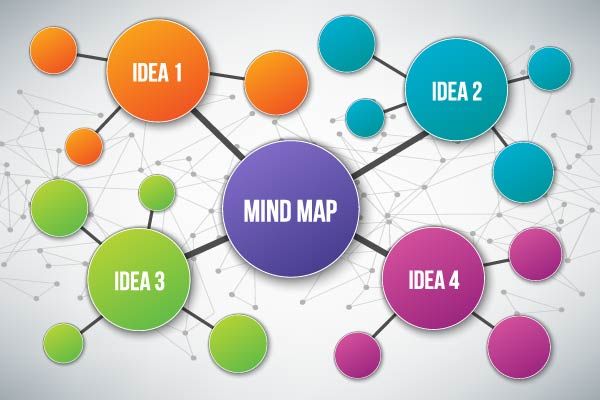Mind mapping is a fun way to brainstorm ideas, digest information, or organize your thoughts and goals. I'm no stranger to mind mapping; I've created them frequently over the years. It’s fun, effective, and utilizes the natural processes of the brain.
Estimated reading time: 3 minutes

What Is Mind Mapping?
The basic premise is to use pictures, words, colors, and nonlinear forms to create, remember, organize, or present information. By using visuals and symbols, more of the brain is accessed. When more brain power is applied, things can be processed, presented, or remembered more easily. It's also a great tool to set the foundation for visualization.
The late Tony Buzan, coined the term and technique, Mind Mapping, in the 1960s. Buzan is a specialist in innovation, memory, thinking process, and creativity.
Mind mapping was introduced to me by Professor Brenda McKinney. In 2010, I took her class, Poverty and the Brain, and every single assignment was created using mind maps. At first, it seemed really weird and quite frankly, too fun, to be creating assignments using mind maps, but in the end, it allowed me to process and remember the information much better than notes or essays would have.
How I Use Mind Mapping Personally
Even now, nine years later, I can pick up my mind map assignments and understand and apply the information in my work and life. With one quick glance at only one paper, information comes flooding into my brain. It would have taken 5-6 pages of notes or essay writing to digest and process the same information.
Mind maps are invaluable!
In my personal life, I use them frequently for emotional processing, creating to-do lists, organizing information, and taking notes. I also teach this method to my middle school students. A number of my students have told me that they use them similarly in their lives. It’s also been beneficial to apply mind mapping to help students process emotional and relational stresses at school.
The quickest way for me to create a mind map is to grab colored markers or pencils and some paper. However, there are now many great software or computer drawing options, if you prefer. I also tend to use more words than pictures; however, it's a good practice to include at least a few pictures every time because pictures facilitate brain processing much faster than words do.
![]() If you want to try mind mapping and experiment, here are the instructions below.
If you want to try mind mapping and experiment, here are the instructions below.
Step-by-Step Process of Mind Mapping
- Start in the CENTER of a blank page turned sideways. Why? Because starting in the center gives your brain freedom to spread out in all directions and to express itself more freely and naturally.
- Use an IMAGE or PICTURE for your central idea.
Why? A central image is more interesting, keeps you focused, helps you concentrate, stimulates your imagination, and gives your brain more of a buzz! - Use COLORS throughout. Why? Because colors are as exciting to your brain as images. Color adds vibrancy and life to your mind map, as well as adds tremendous energy to your creative thinking, and is fun!
- CONNECT your MAIN BRANCHES to the central image and connect your second and third-level branches to the first and second levels, etc. Why? Because your brain works by association. It likes to link two (or three, or four) things together. If you connect the branches, you will understand and remember a lot more easily.
- Make your branches CURVED rather than straight-lined. Why? Because having nothing but straight lines is boring to your brain.
- Use ONE KEY WORD PER LINE. Why? Because principal words give your mind map more power and flexibility.
- Use IMAGES throughout. Why? As the saying goes: pictures are worth a thousand words. If you have ten images in your mind map, it’s equal to 10,000 words of notes!
And if you’d like to learn more, a great article to read is “How to Use Mind Maps to Unleash Your Brain’s Creativity and Potential” by LifeHacker."
I will forever be thankful to Professor McKinney for introducing me to this amazing form of information processing. It is integral to my emotional and mental health and something I will continue to teach my students and children for many years.
To learn more about Heartmanity coaching programs, contact us at support@heartmanity.com.








